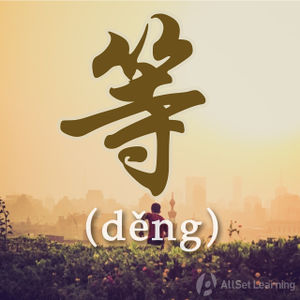Difference between revisions of "Non-exhaustive lists with "dengdeng""
m (Text replacement - "péngyǒu" to "péngyou") |
m |
||
| Line 26: | Line 26: | ||
*我 有 很 多 外国 朋友 , 美国人、英国人、西班牙人 <em>等等</em> 。 <span class="pinyin">Wǒ yǒu hěn duō wàiguó péngyou, Měiguórén, Yīngguórén, Xībānyárén <em>děngděng</em>.</span> <span class="trans">I have a lot of foreign friends: Americans, British, Spanish, etc.</span> | *我 有 很 多 外国 朋友 , 美国人、英国人、西班牙人 <em>等等</em> 。 <span class="pinyin">Wǒ yǒu hěn duō wàiguó péngyou, Měiguórén, Yīngguórén, Xībānyárén <em>děngděng</em>.</span> <span class="trans">I have a lot of foreign friends: Americans, British, Spanish, etc.</span> | ||
*我 的 男朋友 会 说 很 多 外语 , 英语、法语、西班牙语 <em>等等</em> 。 <span class="pinyin">Wǒ de nánpéngyou huì shuō hěn duō wàiyǔ, Yīngyǔ, Fǎyǔ, Xībānyáyǔ <em>děngděng</em>.</span> <span class="trans">My boyfriend can speak many foreign languages: English, French, Spanish, etc.</span> | *我 的 男朋友 会 说 很 多 外语 , 英语、法语、西班牙语 <em>等等</em> 。 <span class="pinyin">Wǒ de nánpéngyou huì shuō hěn duō wàiyǔ, Yīngyǔ, Fǎyǔ, Xībānyáyǔ <em>děngděng</em>.</span> <span class="trans">My boyfriend can speak many foreign languages: English, French, Spanish, etc.</span> | ||
| − | *你 带 一 些 纸、笔 <em>等</em> 东西 吧 。 <span class="pinyin">Nǐ dài yī xiē zhǐ, bǐ <em>děng</em> dōngxī | + | *你 带 一 些 纸、笔 <em>等</em> 东西 吧 。 <span class="pinyin">Nǐ dài yī xiē zhǐ, bǐ <em>děng</em> dōngxī ba.</span> <span class="trans">You bring some paper, pens and so on.</span> |
*中国、印度、巴西 <em>等</em> 国家 都 很 穷 。 <span class="pinyin">Zhōngguó, Yìndù, Bāxī <em>děng</em> guójiā dōu hěn qíong.</span> <span class="trans">China, India, Brazil and so on are poor.</span> | *中国、印度、巴西 <em>等</em> 国家 都 很 穷 。 <span class="pinyin">Zhōngguó, Yìndù, Bāxī <em>děng</em> guójiā dōu hěn qíong.</span> <span class="trans">China, India, Brazil and so on are poor.</span> | ||
Revision as of 02:35, 13 August 2015
-
Level
-
Similar to
-
Used for
-
Keywords
等等 (děng děng), or simply 等 (děng), is just like saying “and so on” or “etc.” in English. Both are placed after listing a series of items (generally with a list that exceeds two items).
Structure
The basic structure is easy. Just make a list of things, and add 等 (děng) or 等等 (děng děng) to the end of the list. It's the same as in English when we use "etc." at the end of a list.
A1,A2...等/等等
Examples
- 我们 有 茶、牛奶、可乐 等 。 We have tea, milk and Cola etc.
- 我 喜欢 看 书、逛街、睡觉 等 。 I like to read books, window-shop, sleep etc.
- 西瓜、菠萝、苹果、葡萄 等等 , 都 是 我 喜欢 的 水果 。 Watermelons, pineapples, apples, grapes and so on are all the fruits that I like.
- 上海、北京、深圳、香港 等 , 我 都 去 过 。 Shanghai, Beijing, Shenzhen, Hong Kong etc., I have all been to.
- Jackie Chan、Jet Li、Bruce Li 等 都 是 中国 有名 的 功夫 明星 。 Jackie Chan, Jet Li, Bruce Li, etc. are all famous Chinese martial arts stars.
- 长城、故宫 等 地方 都 是 北京 有名 的 景点 。 The Great Wall, the Summer Museum, etc. are all famous Beijing scenic spots.
- 我 有 很 多 外国 朋友 , 美国人、英国人、西班牙人 等等 。 I have a lot of foreign friends: Americans, British, Spanish, etc.
- 我 的 男朋友 会 说 很 多 外语 , 英语、法语、西班牙语 等等 。 My boyfriend can speak many foreign languages: English, French, Spanish, etc.
- 你 带 一 些 纸、笔 等 东西 吧 。 You bring some paper, pens and so on.
- 中国、印度、巴西 等 国家 都 很 穷 。 China, India, Brazil and so on are poor.



